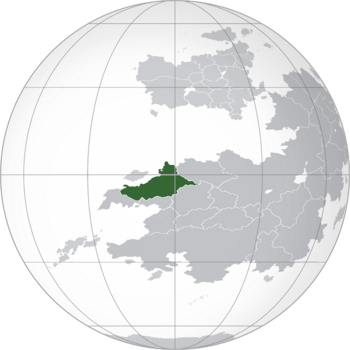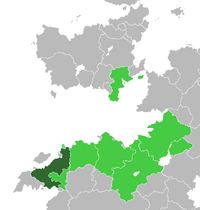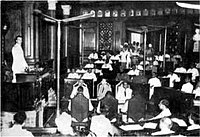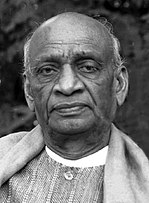User:Geordinia/sandbox2
Kingdom of Rajyaghar રાજ્યઘરનું રાજ્ય | |
|---|---|
| Motto: Rājā nī Jaya Hail to the King | |
| Anthem: Kramākramānē Step by Step | |
 Location of Rajyaghar in Coius | |
| Capital and largest city | Kinadica |
| Official languages | Himavantan |
| Recognised regional languages | Zubadi, Bhasdila, !Sindhi, Vijayan |
| Demonym(s) | Rajyani |
| Government | Federal, Parliamentary, Constitutional Monarchy |
• Maharaja | Krishan VII |
| Prince Akash | |
• Premier | Madhava Thakur |
| Vishnu Kapadia | |
| Legislature | Shahee Sansad |
| Council of States | |
| House of Representatives | |
| History of Rajyaghar | |
• Fall of the Rajana Dynasty | 815 CE |
• Creation of Satria Etruriana | 1847 CE |
• Independence from Etruria | 1946 CE |
| 19XX CE | |
• Saṅghīya Constitution | 19XX CE |
| Area | |
• Total | 1,254,462 km2 (484,350 sq mi) |
| Population | |
• 2020 census | 112,215,631 |
| GDP (PPP) | 2020 estimate |
• Per capita | $35,637 |
| GDP (nominal) | 2020 estimate |
• Per capita | $14,255 |
| Gini (2021) | 42 medium |
| HDI (2021) | medium |
| Currency | Rajyani Rupee (₹) (RR) |
| Time zone | UTC-2 |
| Date format | dd/mm/yyyy (CE) |
| Driving side | left |
| Calling code | +52 |
| Internet TLD | .ra |
Rajyaghar, officially the Kingdom of Rajyaghar, is a Coian country in Satria. The sixth most populous country in the world, the Kingdom of Rajyaghar is a federal parliamentary constitutional monarchy that includes XX Union States, 2 Federal Territories and 1 Autonomous Province. Rajyaghar shares a land border to the north with Ghamistan, XX to the east, XX to the south and Padaratha to the south-west. To the west, Rajyaghar is bounded by the Aechelion Sea and the island nation of Venikara. The capital and largest city in Rajyaghar is Kinadica within the Capital Federal Territory.
Since the 19XX XX Seccession, the Kingdom of Rajyaghar has consisted of XX Union States, 2 Federal Territories and the Autonomous Province of XX. Rajyaghar covers 1,254,462 square kilometres (484,350 sq mi) with an estimated 2021 population of over 110 million people. Moving from the coast inland, Rajyaghar's geography is highly diverse ranging from the western lowlying coastal regions to the tropical forests that lie before the Pavitra Mountain range which separates western Rajyaghar from the eastern flat plateau.
Rajyaghar is a fast-growing economy with a rapidly expanding information and technology sector which has moved the economy from being focused on agriculture to an increasingly diverse economy. With these changes, the country has seen a booming middle class which has transformed Rajyaghar into a consumer society. In the last two decades, there have been major government initiatives which have focused on literacy which have increased the literacy rate from 17% to 79% in 2020. This has also resulted in more people moving from the rural areas to the urban cities and towns which has resulted in the Kakeki metropolitan area. In order to prevent the development of slums that began to emerge across Coius during the late colonial era and post-Solarian War period, the early Central Union Government introduced basic welfare programmes and initiated public housing schemes.
A secular, federal, constitutional monarchy since independence in 1946, Rajyaghar has been governed via a democratic parliamentary system. A developed country with a strong parliamentary democracy since the Saṅghīya Constitution, the Kingdom is centred upon its conservative but libertarian principles with it being one of the first in Coius do legalise women's suffragae in 1960 and legalising same-sex marriage in 1990. Society itself is highly diverse due to its large multi-ethnolonguistic demographics.
Rajyaghar is a member of the Community of Nations and Council for Mutual Development and a founding member of Bashurat Cooperation Organization. The country also has maintains close political and cultural ties to its southern neighbour Padaratha and linguistic and cultural ties with XX, Venikara and Ghamistan.
Etymology
The etymology of the name "Rajyaghar" is derived from the !Gujarati words of "Raja" and "Ghar" meaning King and Home respectively. Translated literally, the name means Home of the Kings and was what early Euclean Imperialists would refer to the region during the colonial era. A similar name, "Rajyamina" was used by Satrians throughout the !medieval period to refer to the land that now makes up Rajyaghar and XX due to the dozens of Madhyarajyas that goverened the land prior to colonisation. Modern day Rajyaghar is still considered the Land of Kings due to its federal system of government in which all of the Union States and the Autonomous Province of XX have ceremonial Heads which are descendants of the pre-colonial Maharajas which reigned over the pre-colonial Madhyarajyas.
The usual way to refer to a citizen of Rajyaghar is "Rajyani".
History
Ancient Rajyaghar
Text
Medieval Rajyaghar
Text
Colonial Rajyaghar
Under Etrurian control, changes were made to the former middle kingdoms that would remain in place even after independence. Changes included the consolidation of power into a centralised government led by the Etrurian Colonial Office. Educational, manufacturing, industrial and infrastructure reforms were undertaken. The creation of major infrastructure links, including canal systems, railways and the telegraph, increased the influence and power of the colonial regime and also allowed for the rapid movement of natural resources from Satria Etruriana to factors on the coast where the raw goods were turned to usable materials which would be transported across the globe by Etrurian companies.
The economic and social reforms introduced came with increased surveillance and control from the Etrurian regime which fostered resentment amongst the native populations. The transportation of natural resources out of Satria Etruriana also angered the native population which would eventually result in the 1913 Chanak Rebellion. The rebellion came shortly after Etruria faced the Khordad Rebellion in Pardaran in 1912. The rebellion would highlight the invasive etrurian social and economic reforms and would also demonstrate the ruthlessness of the etrurian regime in suppressing dissent. Although the rebellion was suppressed, it had laid the foundation for the independence struggle that would persist and grow.
The Great War saw the involvement of hundreds of thousands of Satria Etrurianan men under the Corpo di Soldati Ausiliario Satriani. The agreement to supply the colonial army with more troops from the native population was made by the Consular Senate, an advisory committee established by the Etrurian Colonial Empire in response to the 1913 Chanak Rebellion. The Senate had also secured guarantees that following the war a native legislature would be established for some self rule to be exercised. Following the war, a legislative assembly was established but was granted nominal powers, fueling greater resentment against Etruria. Calls for greater self rule increased following the Great War and throughout the subsequent Solarian War. Etruria’s collapse during the Solarian War and the devastation inflicted on Satria would see independence leaders turn to the Community of Nations for assurances of independence in return for Satria Etruriana’s withdrawal from the war. In 1946, the northern states of Satria Etruriana surrendered in the Solarian War in return for independence being granted in October 1946.
After a century of colonial oppression, the form that an independent Rajyani government would take were questioned. Many of the independence leaders were the descendants of the former rulers of the middle kingdoms and wanted to see their power and influence restored post-independence. Many of the rank and file members of the independence movement feared that after colonial rule, the monarchy would be a tool for establishment oppression against the common people. However, fears of communist insurgencies in the southern states of Sasipur and Sangam as well as ethnic tensions in Pinjar and a substantial irfanic minority in the eastern states led many to fear that without a strong central government with a unifying theme, an independent rajyaghar would quickly collapse.
A republican system of governance brought the risk of a communist takeover or rise of minority leadership at the presidential level if there was a charismatic, unifying minority figure and this worried the rajyani establishment as there were already examples of these in the independence movement. A constitutional monarchy was seen as a compromise between the hardliners in Sanyukt and Rathankot who wished to return to the medieval systems of governance and the socialists in the south who wished for a more democratic society. The monarchy would also rule out the possibility of an irfanic or other minority head of state which alleviated the fears of the Ashankic establishment who believed that if a minority were to become Premier, their power could be tempered by the Shahee Sansad and Monarchy. Throughout the independence struggle, Prince Krishan VI or Sanyukt had also been a fierce supporter of the ethnic minorities and so his appointment as the Maharaja was seen as a nod to those groups who feared that a monarchy would only represent ashanku interests. There were also fears that a presidential system would see complete ashankic-dominance in the politics of the country.
Independent Rajyaghar
The end of the Solarian War saw the end of Etrurian colonial rule over Satria Etruriana and the establishment of the newly independent Kingdom of Rajyaghar. At the time of independence, Satria was consumed by destruction following the Great War and subsequent Solarian War. Despite this, Rajyaghar had significant economic advantages. Rajyaghar was one of the largest producers of iron, and the industrial infrastructure built by Etruria was designed for efficient production, refinement and exportation of Rajyani natural resources. The resources also gave the Rajyani government the resources it would need to recover following the Solarian and Great Wars as well as invest in further industrial development and infrastructure.
Independence itself resulted in increased tensions throughout the Kingdom. Prior to independence, nationalist groups in Tarkhana, Pinjar and Zulmat had attempted to convince the Community of Nations to support their attempts at independence as separate nations but fearing Ajahadyan dominance, Rajyani leaders were able to persuade the CoN against such action. There were also fears that communist support in eastern states would lead to insurgencies. It was also known that Ajahadya was also funding communist groups in Sangam and Sasipur in an attempt to undermine the Central Union Government.
Under the leadership of Premier Baiju Pahir Kapadia and his centrist People’s Party, the government placed a large emphasis on state planning with the military, education and investment receiving the largest amount of funding. These plans helped revive the economy following the wars of the early 20th Century and protect Rajyani sovereignty and integrity whilst Ajahadya attempted to spread pan-satrian unity across Satria.
In 1946, less than two months after independence, the First Satrian War broke out across Satria. Continued Ajahadyan interference in domestic matters led to a large-scale build-up of forces along the Ajahadyan-Rajyani border with a concentration of forces in the Union State of Pinjar. The First Satrian War would roughly establish the borders of the modern-satrian nations with Rajyaghar and Arthadesh laying the foundations for their special relationship during the war with the signing of a treaty of mutual defence.
The immediate aftermath of the war saw the split of the People’s Party under Kapadia into the centrist Liberal Party and socialist Cooperative Party. Under Kapadia’s successor, Anand Mahanti, the cooperative party established the national health service, codified the national educational curriculum and raised taxes in order to pay for social programmes. Slowing economic growth, increased communist threats from Sasipur and growing ethnic tensions in Pinjar saw Mahanti’s cooperative party lose the 1955 election to the Liberals under Onkar Jariwala. Jariwala’s liberals would reverse the tax code of the CP and much of their socialist economic reforms. During the late 50s, the government would also crack down on the communist insurgencies in Sasipur, banning the local communist party and placing many of its members under house arrest.
The failure of the Liberals to handle the !sindhi riots and the resurgence of the communist insurgency in Sasipur would see the Rajyani Rashtriya Party come to power in 1960 following the ‘’year of instability’’ in 1959 in which no party could secure enough seats to form a government. Religious tensions between the dominant ashankic majority and the minority faiths had also resulted in the pro-ashankic RRP succeeding in the polls. Under the RRP’s Abhinav Devdhar Malhotra, the government fiercely cracked down on dissidents and quelled the insurgencies. The breakout of the Second Satrian War in 1959 had also allowed Malhotra to call for increased military spending but its effects would not be seen until Pinjar and Sangam fell to Ajahadya. The remainder of the war would see Malhotra’s government scramble to retake the lost provinces but by the war’s conclusion, Rajyaghar had lost all of Pinjar, seen the death of Krishan VI and witnessed the assassination of Rajaram V. Using these crises, and following a deadly riot, Malhotra would successfully declare a State of Emergency allowing the RRP to ban the communist party, crack down on ethnic and religious minorities and imprison political dissenters and opponents. In the 1965 election a year into ‘’the Emergency’’, the RRP were returned to power with an increased majority and would continue to enact their oppressive social policies as well as their radical economic reforms. During this time, the economy would transform from one based on agriculture to a manufacturing and industry dominated economy with rapid urbanisation and growing middle class.
1967 saw the RRP turn against Malhotra due to his authoritarian tendencies and a national government was established. The cooperative party would return to power in 1968 ushering in social reform and rewriting the tax code. The 1970s would see increased religious tolerance, continued economic growth and the opening up of the economy to outside investment. The 70s would also see increased cooperation between Rajyaghar and the Senrian-alligned nations of Satria. In 1972, Rajyaghar, Baekjeong and Arthadesh would form a coalition to retake lost territory from Ajahadya by initiating the Third Satrian War. The war would see the drawing of modern borders and the retaking of western Pinjar by Rajyaghar.
The RRP would return to power in the 1980s, with a brief absence from government between 1985-88 as a result of failed agricultural reforms. Rajyaghar’s first female Premier, Kalyani Bajpeyi of the RRP, would usher in an ‘economic renaissance’ with a reduced and simplified tax code, deregulation and privatisation. Bajpeyi’s victory over the unions in the ’89 National Strike would see the end of union dominance in rajyani politics. Throughout the late 90s and early 2000s, social reform would rock Rajyani culture with continued economic growth seeing the emergency of Rajyaghar as a middle-income economy. However, in 2006, the economy would be hit by the collapse of the housing market which would see Rajyaghar enter a recession for the first time since independence.








